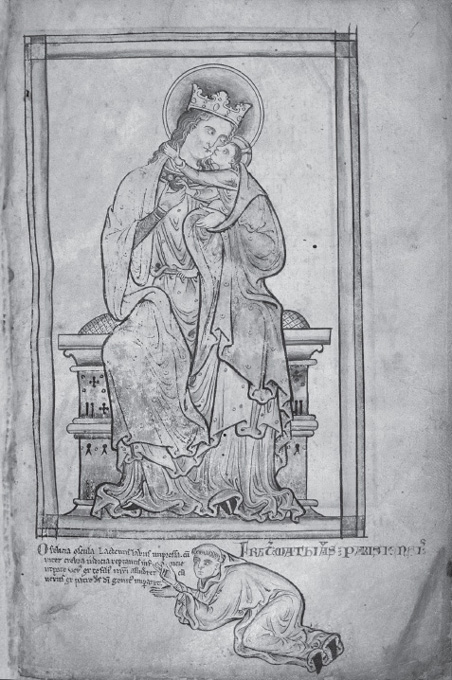

A DISTINGUISHED EXAMPLE OF MEDIEVAL CARTOGRAPHY AND ILUSTRATION
Matthew Paris’s map of Britain is depicted in the first plate section.
It was not until the sixteenth century, with the invention of triangulation, that maps conveyed with at least some relative accuracy the shape and scale of the British Isles. Earlier generations of travellers were largely forced to rely on local knowledge or to keep to the major tracks. Indeed, before the mid-thirteenth century, the few Britons familiar with cartography had to make do with representations that were more schematic than geographical.
Around 1250, an English monk named Matthew Paris (c.1200–59) drew a series of maps that are far more accomplished than anything that survives prior to that time. Although to the modern eye his depiction of Britain is greatly removed from reality, his draughtsmanship nonetheless aimed at rendering the country in an essentially accurate rather than schematic fashion.
At first glance, the claim to accuracy hardly rings true. The coastlines of Wales and Scotland (which Paris thought was almost totally dissected from the mainland by the Firths of Clyde and Forth) are not recognizable. Indeed, only the basic shape of Cornwall can be easily discerned. However, the picture becomes clearer once it is understood that the map’s central artery is the road from Dover to Berwick. Thus Kent does not stick out to the south-east of London but lies due south, roughly where the Isle of Wight ought to be. Once this is comprehended, suddenly the rump of East Anglia, for instance, can be made out.
It is not just the importance of the Dover–Berwick road that should be noted but also the emphasis given to those other sources of navigation, rivers. London is clearly marked as the most important city among the over 250 places and features named. ‘Snaudun’ marks the mountains of Snowdonia. More surprisingly, both Hadrian’s Wall and the Antonine Wall are depicted, despite having tumbled into ruin over 800 years previously. This suggests that Paris may have had access to Roman manuscripts that have since been lost. The eastern slant of Scotland replicates the cartography of the second-century Greek astronomer, Ptolemy.

On the frontispiece of his Historia Anglorum, the monk kneeling beneath the Virgin and Child is, in fact, a self-portrait of the author, Matthew Paris.
Paris’s significance was not confined to cartography. As a chronicler of his times, he wrote over a million words and his most important work was the Chronica Majora. In it, he updated the Flores Historiarum (‘Flowers of History’) of Roger of Wendover, one of his predecessors at the Benedictine abbey at St Albans. To Roger’s history, from the Creation to 1234, Paris added his contemporary analysis of the years 1235 to 1259. It is a remarkable narrative, suffused with news and gossip. Paris was not a detached and cocooned scholar but a man familiar with some of the greatest figures in the realm. When away from St Albans, he appears to have spent much time attending ceremonial events and court occasions, where he hobnobbed with some exceptionally well-placed sources for his testimony. A trip to Bergen even led to a meeting with Hákon IV of Norway.
Angevins
Henry II 1154–89
Richard I ‘the Lionheart’ 1189–99
John 1199–1216
Plantagenets
Henry III 1216–72
Edward I 1272–1307
Edward II 1307–27
Edward III 1327–77
Richard II 1377–99
(House of Lancaster)
Henry IV 1399–1413
Henry V 1413–22
Henry VI 1422–61 and 1470–71
(House of York)
Edward IV 1461–70 and 1471–83
Edward V 1483
Richard III 1483–5
Paris was a confidant of both King Henry III and his younger brother, Richard of Cornwall, who, as ‘King of the Romans’ and an aspirant to the throne of the Holy Roman Empire, was active in the politics of the German lands. Frequently critical of the pope, Paris was also a staunch defender of English rights, lacing his chronicles with his own opinions and prejudices. Thus, while they cannot be regarded as either impartial or, in places, strictly accurate, they do provide telling and often first-hand knowledge of English politics. Furthermore, they were written from the standpoint of someone whose independent spirit was such that he could accept King Henry’s patronage and admire his piety, yet comment critically on his political skills and indecisiveness. ‘The lot of historians,’ Paris sighed, ‘is hard indeed, for, if they speak the truth, they provoke man, and if they record falsehoods, they offend God.’
Paris decorated his chronicles with illustrations, often in the margins. Although his artistry was naive by some contemporary standards, his efforts to observe from life, as well as merely copying stylized reproduction, earn him a significant place in the development of British art. He drew some of the earliest known depictions of London and his picture of an elephant is justly famous. His Historica Anglorum is prefaced with tinted line-drawings of the English kings. Since he knew Henry III personally, his representation of him there may even be relatively accurate.
Matthew Paris’s Chronica Majora is kept at Corpus Christi College, Cambridge.